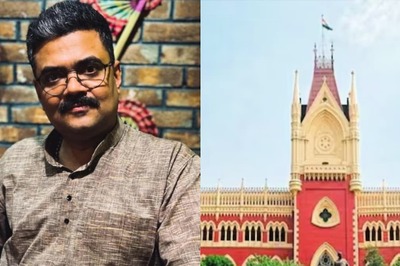
views
The Lok Sabha Verdict
With seven phases, 542 seats, 8000 candidates, 61-crore electors, the world’s biggest democratic exercise is set to come to a close today with the final tally of the votes polled. From heated campaigns to contentious poll code calls to violence and fistfights, the 39 days of voting have seen it all.
Will the National Democratic Alliance (NDA) clinch a second thumping victory (like the News18-IPSOS seems to indicate)? Or will the Opposition parties turn the tables around?
This is how you can keep up with counting day:
-> From the politically crucial state of Uttar Pradesh to the single seated union territories, track the tally of Battle 2019 here.
-> Find out which party is leading in your constituency.
-> Know more about how key candidates like Nitin Gadkari and Sonia Gandhi are faring. Follow the live updates here. Total Recall
And now that the verdict is just around the corner, here is a look back at the highs and lows of Lok Sabha elections 2019.
The EC Rules: Lok Sabha elections 2019 will also be a memorable one given the unprecedented number of campaign bans. For the first-time ever, the Election Commission barred parties from campaigning in West Bengal’s nine constituencies ahead of the usual deadline. The poll panel also enacted campaign bans on several political leaders including Yogi Adityanath, Maneka Gandhi, Mayawati and Azam Khan for “breaching” the Model Code of Conduct. Despite their seemingly hardline stance, the poll panel still managed to raise many eyebrows, including Commissioner Ashok Lavasa’s, for clearing PM Modi and Amit Shah of all charges of poll violations.
Clash of the titans: The battle of 2019 has been defined by the contest between a strongman party looking to break its 2014 record and a grand-old-party, which is fighting tooth-and-nail to make a comeback. The neck-and-neck battle between its leaders – BJP’s Narendra Modi and Congress’s Rahul Gandhi has seen the two travel extensively across the country, holding roadshows and rallies. News18 Election Lab put together a tally of their campaign rallies across the many constituencies.
Sexism tracker: They might be pitted against each other in the race to clinch power in the Centre, but one thing that has united most of our netas is the blatant sexism. News18 Election Lab tracked the misogynistic remarks spun by our political leaders during this election campaign. We might not know who the winner of this electoral will be, but we sure do know the party that surpassed all else when it came to shooting off derogatory comments at the country’s female political leaders.Assembly Blues
In the simultaneous Assembly polls held across Andhra Pradesh, Arunachal Pradesh, Odisha and Sikkim, the electorate also caste ballots to vote in a state government.

In Mamata Banerjee's West Bengal, free speech is not for everyone as even sharing a harmless meme of the CM can land you in jail.Election Specials
Ma, Mati, Modi: The Lok Sabha election in West Bengal has been somewhat unprecedented. For the first-time ever the saffron party is likely to make a sizeable impact in the state. But, we can’t brush past the tough fight that Mamata Banerjee’s Trinamool Congress has put up. Since the Birbhum incident three year ago, the TMC and BJP have engaged in both verbal and physical duels, which finally lead to up to the violent exchange during Amit Shah’s rally. From Contai to Cooch Behar, from Darjeeling to Diamond Harbour the political conversations this time eventually whittled down to the binary of Mamata versus Modi, Hindu versus Muslim. Aniruddha Ghoshal’s poignant report looked at the unmistakable rise of Hindutva and communalism in this once-leftist state.
The Other D-voters: The realms of the spiritual and the political often intermingle in a country like India. This is the case for the followers of Ram Rahim’s Dera Sacha Sauda, who usually vote in favour of a party that the group decides. The dera itself constitutes a 13-member political wing with a specific aim to reach out to candidates of different parties to understand what they have to offer to the group. It then holds rounds of discussions in which the followers come to a consensus about the candidate of their choice. Debayan Roy’s fascinating report followed the dera’s followers to guage what their choice could spell for elections in Punjab and Haryana.
How Women Vote? Adrija Bose travelled across Uttar Pradesh, right from PM Modi’s adopted village in Varanasi to Bauri’s Chaundauli and brought us a series, which attempted to understand the frustrations and the motivations of women voters. What stood out for this section of the electorate when they made their choice? Did they largely heed their husbands and caste communities? Or did they consider other election issues? More importantly, were they left impacted by female candidates?
The Silent Voters: The tribal electorate has general reflected an anti-BJP sentiment in Assembly elections in Chhattisgarh, Rajasthan and Madhya Pradesh. In Chhattisgarh, where tribal people make up 30% of the population, the BJP won just four out of 29 tribal reserved seats and the Congress won 24. Something similar happened in Madhya Pradesh, where the saffron party won just 16 of the 47 tribal reserved seats. But will this pattern, which must have been a source of anxiety for the BJP, hold in Lok Sabha polls as well? Suhas Munshi’s report was an eye-opener about the political churning that is taking place within tribal communities and its effects on the elections.



















Comments
0 comment